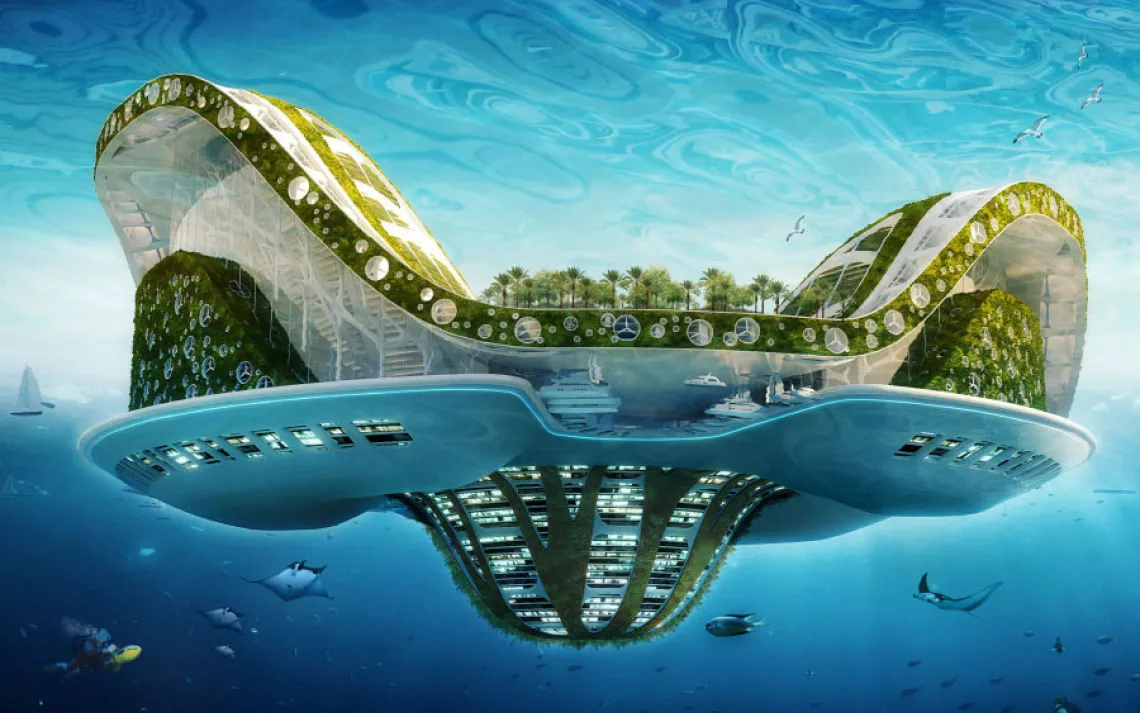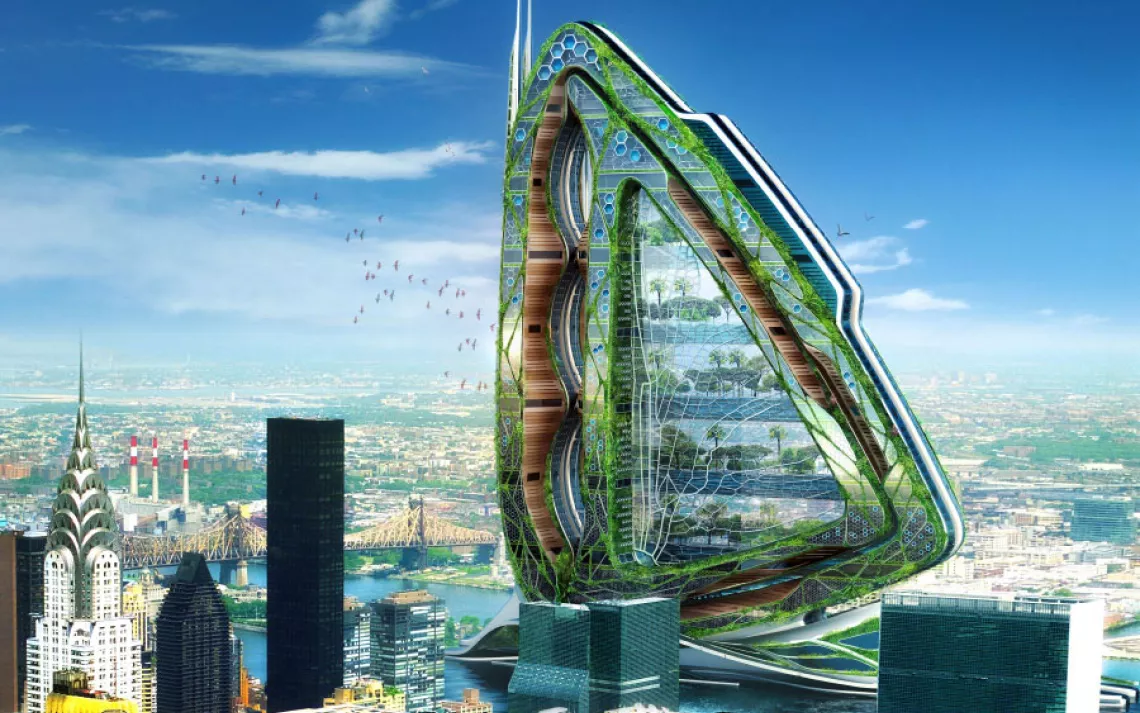Your Future City?
6 Visions for the green city of tomorrow | Text by Colin Griffin

At the 1964 New York World's Fair, General Motors unveiled a utopian vision of what the world would be like 60 years in the future. With fingers crossed, GM predicted a metropolis replete with fossil fuel–powered modes of transportation that would take humans wherever they desired to go: to the Arctic and into the deep oceans (ripe with more fossil fuel, of course) and to space. Smiling families would rumble down pristine superhighways while friendly robots would clear pesky rainforest with laser beams. Urbanites would drift to work on moving sidewalks and catch jets to grab lunchtime burgers on the moon. With fossil fuels, new technology, and unbridled human spirit, the city of the future would know no bounds. So much for that.
Thankfully, our notion of what a city can be has changed a bit since 1964. At a minimum, we no longer aspire to raze critical tropical habitat with lasers to free up space for strip malls. But our futures will continue to be urban, with more than 80 percent of Europeans, North Americans, and South Americans living in cities (and a world population of 8 billion) in 2025. Our cities, though, can be environmentally sustainable. Here are some new visions of the green city of tomorrow, from colossal dragonfly-wing skyscrapers to spherical urban greenhouses.
STUPEFACTION FACTOR:
1 = Pleasant rooftop garden
10 = Self-propelled underwater metropolis shaped like a manta ray
FANTASY FACTOR:
1 = Invest in this project now
10 = Will be constructed as soon as funds arrive from the end of the rainbow

Though none of his arresting concepts have yet come to fruition, Belgian architect Vincent Callebaut may be the most prolific designer of fantastic future cities. Callebaut designed the Lilypad, basically a giant ocean-bound football stadium carpeted with foliage, as an unmoored refugee camp for people displaced by rising seas and other impending environmental hazards.
STUPEFACTION FACTOR: 8
While Callebaut doesn't propose a specific size for his Lilypad, he guesses that each one could house 50,000 refugees, which is equivalent to the population of a city the size of Cheyenne, Wyoming. Imagine a random assortment of disgruntled climate refugees drifting about the world's oceans in a tree-covered half pipe.
FANTASY FACTOR: 9
In the unlikely event that everyone on Earth went crazy and decided that this would be the best way to house those affected by environmental problems, we would still have to figure out how to fund the thing. And the only people with enough money to launch the project probably depend on environmental destruction for their income.

The first-place winner of architecture magazine eVolo's 2010 Skyscraper Competition, LO2P consists of a ring of greenhouses surrounding a giant turbine and particle collector. The building, made from recycled cars, would suck pollutants out of Delhi's increasingly filthy skies and spit out waste products to be turned into biofuels. It is the vision of French firm Atelier CMJN.
STUPEFACTION FACTOR: 6
This would be just like one of those infomercial home air purifiers, except instead of inhaling all of your cat's dander, it would produce breathable air for the residents of one of the world's most polluted cities.
FANTASY FACTOR: 8
There are plenty of systems already in existence that use plants to purify air and water. None of those systems require an enormous whirling blade operating 24/7 in the middle of a massive population center.

With his Dragonfly skyscraper, Vincent Callebaut takes the almost worn-out "vertical urban farm" concept and gives it a massive dose of hallucinogens. At more than two and a half times the height of the Empire State Building, the dragonfly wing–shaped über-farm would tower over Manhattan, housing everything from apricot orchards to livestock pastures.
STUPEFACTION FACTOR: 10
America's tallest building, in its largest city, would be a futuristic Noah's Ark, a symbol of our nation's commitment to the environment and a stunning example of the strength of mankind. Moreover, it would be shaped like a freaking dragonfly wing.
FANTASY FACTOR: 10
This will not happen. Ever.

Founded by two Harvard-trained architects, Terreform is a futuristic-city think tank, churning out designs for everything from eco-race cars to environmental overhauls of major cities. Terreform claims that if current systems of transportation were replaced with the hop-on, hop-off Blimp Bumper Bus, which is essentially a bunch of swings hanging from a balloon, urban traffic efficiency would increase by 30 percent.
STUPEFACTION FACTOR: 8
Chains of brain-shaped, automated blimps whisking passengers around our cities would forever liberate humankind from the odd smells and enraging frustration that define current systems of public transportation.
FANTASY FACTOR: 8
Concern about overuse of alliteration alone might prevent the implementation of the Blimp Bumper Bus system. Beyond that, it's hard to conceive of a line of reasoning that would lead a city to strap its denizens to noodles and hang them from zeppelins.

Designed by prominent British architecture firm Foster + Partners (headed by Pritzker Prize winner David Foster), Masdar City is currently under construction in the desert outside Abu Dhabi. Slated for completion in 2030, Masdar will eventually be powered entirely by renewable sources and will provide sustainability-centered living for 40,000 residents.
STUPEFACTION FACTOR: 4
Masdar is particularly awe-inspiring because it represents a novel approach to city planning. But it does so without sacrificing any coolness. Stunning arabesque facades will line the streets, and beneath the city, a complex grid of electric trams and buses will replace fossil-fueled transportation.
FANTASY FACTOR: 1
Despite some financial hiccups, Masdar is being built to its original specifications. This is the actual green city of the future.

Plantagon International claims that its geodesic urban greenhouse could grow plants from seed to harvest with a yield 10 times higher than that of a traditional, sprawling farm. As crops mature, they would climb a spiral conveyor belt, all within the orb's 120-foot diameter.
STUPEFACTION FACTOR: 5
Imagine waking up to find that a gargantuan plant-filled hamster ball now occupies the lot next to your apartment building.
FANTASY FACTOR: 4
The urban greenhouse has already attracted the attention of a few high-profile investors, including the multibillion-dollar Swedish aerospace design firm Saab, and Plantagon is littered with former CEOs and strategists used to transmuting ideas into profit.
 The Magazine of The Sierra Club
The Magazine of The Sierra Club


